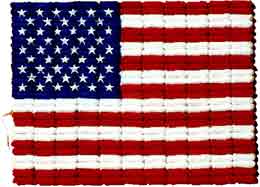|


|

CONTINUED to next
earlier News & Notes

"The Star-Tamponed Banner,"
(Oil, enamel and 286 tampons, 18"x 24")
by one of the few men to contribute of
The Art of
Menstruation: Von
Taylor
(Artist: "No disrespect was intended
by this artwork.")
Letter
to your MUM from Maria
L. Evans, M.D., an associate professor of
pathology [red sections are Finley's
emphasis]:
Just wanted to tell you that I
have occasionally referenced
your site when lecturing my medical
students. I teach the second year Pathology
course here and would actually beg to differ when
you say "it's not about medicine." [I say
that here.]
Part of teaching physicians to
handle a medical practice in
the 21st century is to work with the patient
to create a mindset that is
not solely on prevention of disease but to
promote health. Part of promoting
health and having honest dialogue with
patients is to be able to dispel
cultural myths and taboos.
I discuss a LOT about the
importance of "taking an accurate
clinical history" which means in women with
issues regarding abnormal
or painful or irregular periods, or in
infertility issues, requires accurate
and frank discussion about menses. Most second year
medical students, regardless of sex, are
totally clueless as to what "normal"
menses are. They can accurately guess as
to number of days but when I ask
questions like "how many days did they
pass clots and how many days
was it just brown streaky stuff" they look
at me like I'm crazy. Males
are oblivious and females think "normal"
is what THEY do on their
period.
I find myself discussing these
things with my students and
when they do workups on their "simulated
patients" (people we
hire to pose as patients for purposes of
teaching them to do an accurate
history and physical and practice writing
notes and plans for care), well,
if you reviewed the tapes of how the
students look when taking things like
menstrual history, sexual history, etc.,
with me....well, it is just sad,
the level of embarrassment they have asking
these questions. Learning to
ask frank and intimate questions in a
professional and unembarrassing way
is a KEY learning component of clinical
medicine, as well as identifying
where the patient may be relying on myth or
urban legend to make educated
health decisions.
So I would say, yes, your
museum is mostly cultural but there
is a very important medical side to it when
you look at it in terms of understanding
wellness enough to differentiate it from
disease!
Keep up the good work. I hope
the museum has a physical home
someday.
Maria L. Evans, M.D.
Associate Professor, Pathology
Kirksville College of Osteopathic Medicine
Kirksville, MO
"To be opened only by
WOMEN":
A German Tampax
brochure from the early 1950s.
"Invisible"
Another German tampon brochure: Amira, early 1950s
So, what does o.b. REALLY mean
(part
2)?!
Learn what o.b. means
- as in the tampon!
Old-fashioned pads still in
office dispenser
Okay; I feel kind of odd
writing to you when I don't even know you
and you don't know me ... but I'm writing
to you today, because ... well, I like
your Web site and thought this might
interest you.
Put briefly: I work in a
building that is predominantly men. And
yesterday, my period decided to surprise
me at work and I had forgotten my faithful
Keeper at home. So what's a woman to do?
Luckily, the ladies' room had one of those
pads dispensers, and I didn't really
think twice as I walked over to it to
purchase a pad.
The first thing I noticed
odd was that the cost advertised on the
front of the machine was a dime per pad.
Most machines want a quarter or even two
quarters for a pad or tampon, so I figured
maybe the machine was old and the price
was outdated. But the slot was only big
enough for a dime. I put in a dime and
hardly thought it would work -- it must
have been old and empty, right?
Wrong. Out popped a
Stayfree pad in a small, plain cardboard
box. Ordinarily, nothing interesting about
that. Except that I swear this pad must be
from the 70's because it bragged "No
belts! No pins!" right on the front in big
letters.
On the front and side it
identifies the product as a "beltless
sanitary napkin" or "beltless feminine
napkin".
I was shocked. I flipped
over the box again and again. No date on
it, but I know belts went out before I
even began menstruating (I'm 21).
On the back it talks about
how to adhere the pad to your panty or
"panty girdle," whatever a panty girdle
is.
I bought a few to take home
with me, first to see if there was only
just one old pad and it was a fluke; and
then after seeing that the machine was
probably full of them, for novelty
purposes and because, well, I'm a pack
rat. The pad itself inside the box seemed
completely unharmed from time, except for
yellow adhesive (which may have been
yellow to begin with, I don't know how the
early pad adhesives worked).
If you like, I can send you
photos of the pad's box or pad itself, etc
for your website. I didn't see any photos
of it on there, but I could be wrong.
The dispenser itself is
pretty plain and not at all different
looking from a more modern one really,
except for the dispensing mechanism itself
(it's a pull-spring, not a turn-the-knob
type like I'm familiar with).
I don't even know if this
is a strange email for you. But then,
being a man who runs a website and a
museum about menstruation would be
considered strange by most ;) I just
thought you might be interested.
Thanks for reading, if you
did.
Cheers!
|